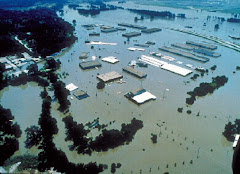Global Warming - Survive and Thrive
By Mark Boardman
A region's climate may alter over time becoming hotter, cooler, drier or wetter. Natural selection will determine the organisms with characteristics appropriate to the new climate. Over hundreds and thousands of generations constant minute changes will eventually lead to a new species that can survive and thrive in the altered climate.
The success or failure of an organism is reliant upon its ability to reproduce young that mature to produce more young. Only the young with the greatest survival traits for any given habitat will endure. These surviving young will transfer their adaptive characteristics to the subsequent generations. This process is known as natural selection
If climatic or environmental changes occur too abruptly some species may not be able to adapt quickly enough and can become extinct. This has become a large problem in recent times with human altered environments changing so rapidly that there has been an ominous rise in the extinction rate
Birds and mammals are warm-blooded (endothermic). This means they can keep their body at a fairly constant, warm temperature by processing body fat and carbohydrates. All other groups of animals are termed ectothermic as their body temperature is dictated by the temperature of the environment around them.
The term cold-blooded is used to describe ectotherms, but this is something of a misnomer, particularly in hot, arid climates. As an example a "cold-blooded" lizard basking in the hot midday sun can easily increase its body temperature to over 100 degrees F, giving it warm blood.
In warm climates organisms need to cool off. Animals' strategies include heat avoidance (by going underground, or into water), or sweating and panting to induce evaporative temperature reduction. Plants must adapt to heat and drought by using leaves to minimise heat stress and water loss.
In cold climates, some endothermic animals continue to be active at night and during the winter, but eat constantly to keep their core temperature steady. Some other approaches adopted by endotherms include minimising heat loss with body insulation such as fat, feathers or hair, or avoidance of adverse temperatures by migration to a cooler environment or burrowing underground, or reducing body temperature by hibernating.
But even man, so often adaptable to the conditions we find ourselves, can be vulnerable to rapid climatic change. The Icelandic Vikings that settled on the south western coast of Greenland in the 10th Century eventually died out within 500 years as they were caught by the grip of the Little Ice Age. This was a period of cooling after a warmer period, known as the Medieval Warm Period.
The Little Ice Age brought bitterly cold winters to the Northern Hemisphere and the Greenland Viking colonies died out simply because they could no longer grow enough food there to support themselves. They had arrived on Greenland in much more favourable climatic times.
So whether endothermic or ectothermic life has a way of surviving, and although our current global warming trend is a serious cause for concern, the earth has seen it all before, and I am sure life will endure.
Mark Boardman BSc dip.hyp is a leading author and expert on the weather.
source : http://ezinearticles.com/?Global-Warming---Survive-and-Thrive&id=1481621


No comments:
Post a Comment